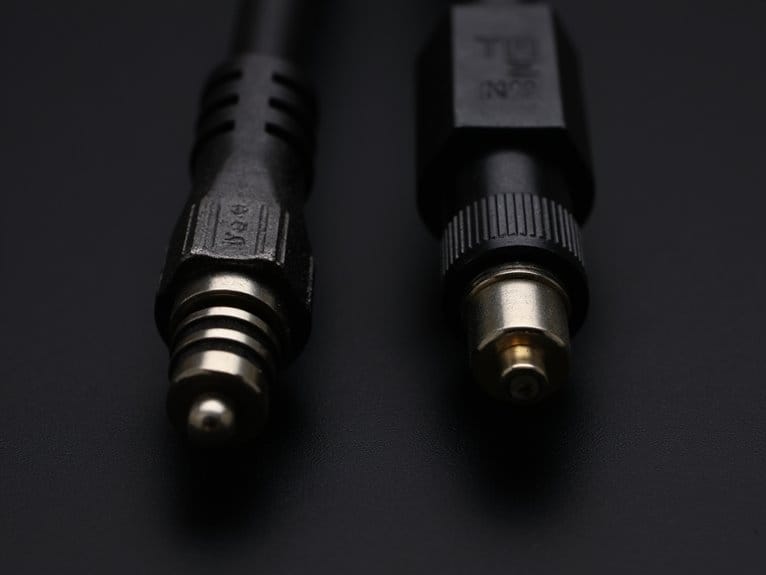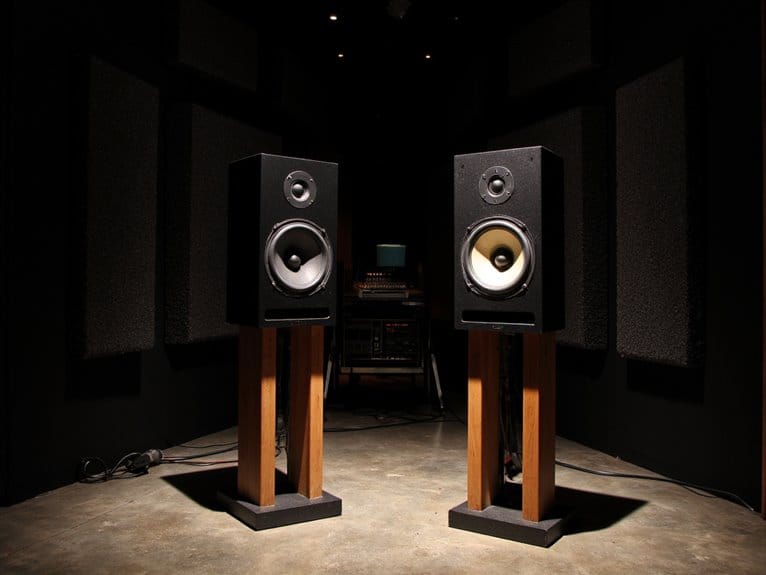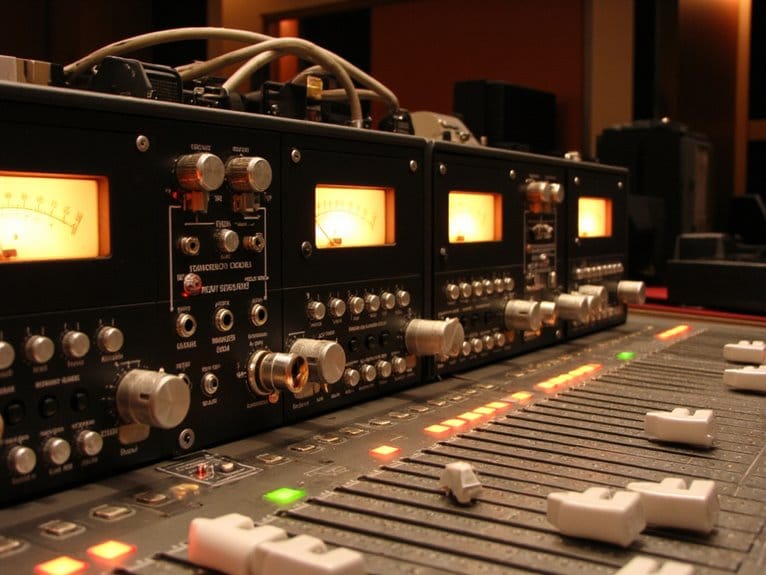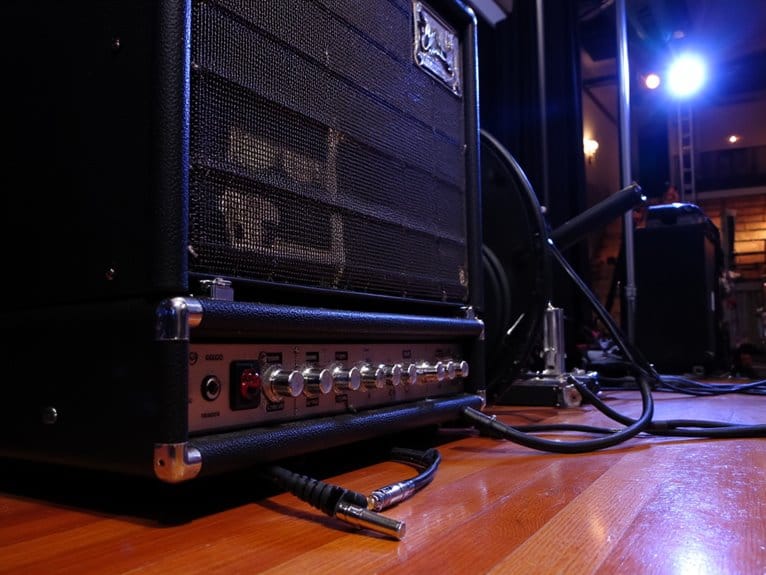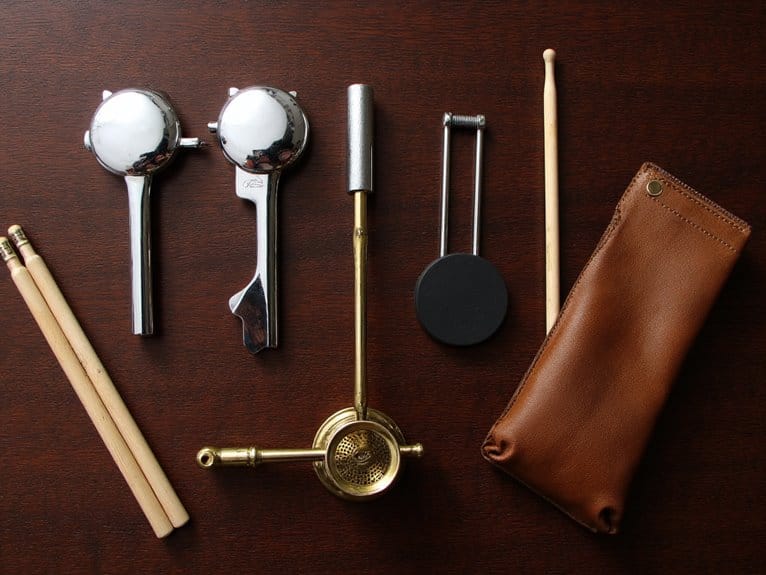TRS Vs TS Cables: Understanding the Difference
You’ll instantly recognize TS cables by their single black ring creating two metal sections, while TRS cables feature two black rings forming three distinct areas, similar to headphone jacks. TS cables carry unbalanced mono signals, perfect for guitars but prone to noise over longer distances, whereas TRS cables handle balanced mono or stereo signals with superior noise rejection through phase cancellation. This construction difference affects everything from studio monitoring to instrument connectivity, and understanding these specifics helps you make informed decisions for your audio setup.
We are supported by our audience. When you purchase through links on our site, we may earn an affiliate commission, at no extra cost for you. Learn more.
Notable Insights
- TS connectors have two metal sections with one black ring, while TRS connectors have three sections with two rings.
- TS cables carry unbalanced mono signals, whereas TRS cables handle balanced mono or unbalanced stereo signals.
- TRS cables provide superior noise rejection through balanced design, especially effective over longer cable runs.
- TS cables work best for guitar-to-amp connections, while TRS excels in studio monitoring and professional setups.
- TRS cables cost more but offer better durability and signal quality in electrically noisy environments.
Cable Construction and Visual Identification
Understanding the fundamental differences between TS and TRS cables starts with examining their most basic distinguishing feature: the number of contact points on their connectors.
I’ve found that TS connectors display two distinct metal sections—the tip and sleeve—separated by a single black insulating ring, while TRS connectors reveal three metal areas with the additional ring contact creating two insulating barriers.
You’ll notice TRS connectors appear slightly longer due to this extra ring, resembling stereo headphone jacks.
The cable materials typically include copper shielding for interference protection, though TRS cables contain three internal wires versus TS’s two-wire construction. These connectors are commonly classified as 1/4 connectors and represent standard sizing in professional audio equipment.
This enhanced internal wiring, combined with strain relief components often found on TRS connectors, contributes to improved connection durability in professional applications. The internal wiring configuration directly corresponds to the signal limitations each cable type can handle in various audio setups.
Signal Types and Audio Capabilities
The core distinction between these cable types lies in their signal-carrying capabilities, where I’ve discovered that TS cables handle unbalanced mono audio while TRS cables can manage either balanced mono or unbalanced stereo signals depending on your specific application.
Understanding these signal types becomes essential when you’re connecting different audio equipment, as the wrong choice can impact your audio fidelity greatly.
Selecting the proper cable type directly affects your audio quality and can make or break your sound setup.
TS cables work perfectly for instruments like electric guitars, where their unbalanced nature isn’t problematic over short distances. However, TRS cables excel in professional environments where noise reduction matters, using their balanced configuration to maintain signal integrity across longer runs. TRS cables are easily recognizable by having three conductors that enable their advanced signal transmission capabilities.
- TS cables carry unbalanced mono signals ideal for electric guitars and basses
- TRS balanced mono connections reduce noise and interference in studio environments
- TRS stereo capabilities enable headphone connections with left and right channels
- Unbalanced TS signals become susceptible to noise over extended cable runs
- Professional audio setups benefit from TRS balanced connections for superior clarity
Noise Reduction and Interference Protection
While signal capabilities matter considerably, I’ve found that noise performance often becomes the deciding factor when you’re choosing between these cable types, particularly in environments where electromagnetic interference can wreak havoc on your audio quality.
TRS cables excel here because their balanced design carries two identical signals out of phase, which cancels noise through phase cancellation at your receiving equipment.
TS cables, unfortunately, act like noise magnets with their single conductor design, especially over longer runs where interference accumulates.
I’ve noticed that proper cable maintenance becomes essential for TS cables since any shield degradation dramatically impacts signal clarity, while TRS cables maintain their noise rejection even in electrically noisy studios packed with computers and lighting equipment.
Professional audio interfaces with high-quality preamps and ASIO drivers significantly reduce noise-related latency issues that can compound cable interference problems in digital recording setups. Quality zero-latency monitoring through dedicated outputs also helps maintain accurate signal timing while reducing the impact of cable-induced interference.
Modern noise cancellation technology can further enhance audio quality by filtering unwanted ambient sounds that cables might pick up from the recording environment.
Common Applications and Use Cases
Three distinct application categories dominate cable selection decisions, and I’ve discovered that matching your cable type to your specific use case eliminates most audio problems before they start.
Instrument compatibility shapes your primary choice between TS and TRS cables, though I’ll admit the learning curve caught me off-guard initially. Electric guitars, basses, and basic keyboards work perfectly with TS cables since they output unbalanced mono signals, while keyboards with stereo outputs require TRS connections for proper audio quality. PreSonus interfaces like the Studio 24c feature balanced TRS outputs that deliver professional-grade signal quality for studio monitoring applications.
Studio environments consistently favor TRS cables for headphone monitoring, balanced line connections, and professional equipment interconnects, where noise reduction becomes critical over longer cable runs and complex signal chains. When connecting microphones to recording equipment, ensure your audio interfaces provide the appropriate XLR inputs and phantom power capabilities for optimal signal transfer. Professional recording setups typically operate at 24-bit/96kHz or higher resolutions to capture maximum detail and dynamic range.
- TS cables excel for guitar-to-amp connections and simple pedalboard patches
- TRS cables handle stereo headphones and studio monitor connections
- Balanced TRS connections reduce noise in professional audio interfaces
- TS cables remain cost-effective for short-run instrument applications
- TRS cables provide superior performance for complex effects chains
Choosing the Right Cable for Your Setup
Since your equipment determines which cable type you’ll need, I’ve learned that starting with your gear’s specifications saves both time and frustration during setup.
Check your audio interface, mixer, or instrument outputs—balanced connections require TRS cables, while unbalanced mono signals work fine with TS cables.
Consider your cable length requirements carefully, as longer runs amplify the noise advantages of TRS cables considerably.
I always verify connector types before purchasing, since mismatched cables can compromise audio quality or eliminate stereo functionality entirely.
For professional recording environments, TRS cables provide superior noise rejection that justifies their higher cost.
However, simple guitar-to-amp connections often work perfectly with budget-friendly TS cables, especially in shorter runs where interference isn’t problematic.
Premium cables with oxygen-free copper conductors enhance signal clarity and reduce noise compared to standard alternatives.
Frequently Asked Questions
Can I Use a TRS Cable in Place of a TS Cable Without Issues?
You can’t always substitute TRS for TS without issues. While TRS versatility allows some compatibility, TS limitations mean devices expecting unbalanced signals may experience noise, weak audio, or connection problems with TRS cables.
What Happens if I Plug a TS Cable Into a TRS Jack?
You’ll experience signal loss when plugging a TS cable into a TRS jack. The ring contact becomes disconnected, converting stereo to mono and reducing audio quality through unbalanced connections and potential noise.
Are TRS and TS Cables Compatible With All Audio Equipment Brands?
You’ll find brand compatibility varies across audio equipment. While TRS and TS cables physically fit most standard jacks, functional compatibility depends on whether your specific device expects balanced or unbalanced signals for peak performance.
Do TRS Cables Cost Significantly More Than TS Cables?
You’ll find TRS cables do cost more than TS cables in most price comparisons. The difference reflects cable quality improvements – TRS cables need extra conductors and better shielding, typically starting around $12 versus $6.
Can I Convert a TS Cable to TRS Using an Adapter?
You can use adapters to physically connect TS cable connectors to TRS jacks, but this won’t create true balanced signals or improve audio quality since the underlying cable lacks necessary conductors.
On a final note
Now you’ve got the knowledge to make informed decisions about your audio connections. Remember, TRS cables handle stereo signals and balanced mono, while TS cables work best for unbalanced mono applications like guitar-to-amp connections. Consider your specific needs, signal requirements, and interference concerns when choosing. Don’t overthink it—match the cable type to your equipment’s outputs and inputs, and you’ll achieve clean, reliable audio transmission every time.

